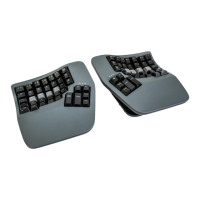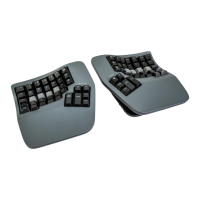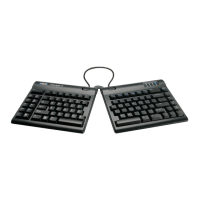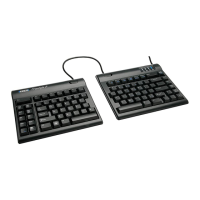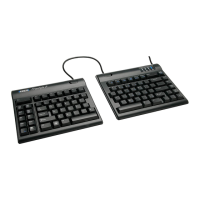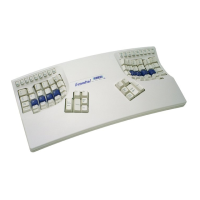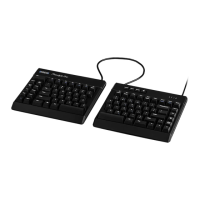29
Remaps use [ ]
Remaps use square brackets and consist of a single Location Token on the left and a single Action Token
This is the opposite from onboard programming where the user first taps the “source” action desired, then
taps the “destination” where the action is desired.
Example: [Location Token]>[Action Token]. This example remaps the Tab key to perform Caps Lock.
[tab]>[caps].
Macros use { }
Macros use curly brackets (aka “braces”) where the Location Token(s) represent the macro trigger. Macros
can be triggered by a single key, as long as that key isn’t associated with one of the default modifier key
locations (even if the modifier has been remapped over). Macros can also be triggered by a key-combination:
one (or more) modifiers keys plus one non-modifier key. When you define a macro trigger, you are defining
that trigger based on the physical location of the trigger key(s), as shown in the Map of Location Token in
Appendix 13.1. A macro can consist of a variety of Action Tokens, either in sequence or in combination.
Example: {Location Token 1}{Location Token 2}...>{Action Token 1}{Action Token 1}{Action Token 1}.
Accessing the layout files
As described in Section 7.3, to access any of the layout files first enter Power User Mode (progm + shift +
esc), and then “mount” the v-drive to your computer (progm + F1). Then open the active folder on the v-drive
to view the .txt layout configuration files. Open the layout configuration file of your choice with a plain text
editing program. If you do not have access to a plain text editor, you may use a different text editing program
(e.g., Microsoft Word) but be sure to select the “plain text” or “simple text” format when saving your changes
to layout configuration file. It is a good idea to rename and save a backup of the layout file on your hard drive.
Listed below are commonly-available text editors for different operating systems:
• Windows: Notepad provides simple text only. Microsoft Word and other word processors can be used if
you save the file plain text or simple text format.
• Mac OS X: TextEdit is the default editor. Under TextEdit “Preferences” select “plain text” as the format.
Normally if you open a plain text file, it will save it in the same format by default.
• Linux: For Ubuntu the default text editor is Gedit, which is similar to Microsoft Notepad.
Important Note: You must save your changes to the layout file (typically using the “File” menu) and
then “Eject,” wait for “okay to remove” message, then close to v-drive to implement your changes.
File Naming Conventions
Qwerty.txt and dvorak.txt represent the two default layouts which are accessed using the onboard shortcuts.
Hotkey layouts are named with the designated hotkey preceding the layout family, either QWERTY or Dvorak.
Examples:
• “a_qwerty.txt” (QWERTY hotkey layout assigned to the hotkey “a”)
• “1_dvorak.txt” (Dvorak hotkey layout assign to hotkey “1”)
Preparing the v-drive for direct editing
If you have a 2MB v-drive and you are planning to directly edit a newly created layout file without having first
done any “onboard” remapping to that particular layout, please review Section 9.1 for guidelines on
“conditioning” files.
Language requirement for direct editing
Your computer must use the English (US) keyboard layout to edit the layout file. Other language drivers use
different codes/positions for certain keys important for programming, such as [ ] and { }. If you want to use
direct programming to make a macro for a language other than U.S. English, it is better to first make the
macro using “onboard programming.” Then you can review and edit it as needed with direct editing. However,
you will need to translate certain tokens in Appendix 13.1 to get the desired output. For keys that change
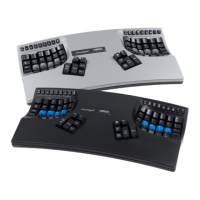
